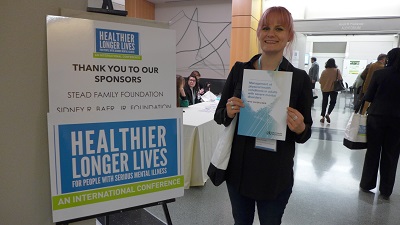
Dr Petra Gronholm, research fellow, King’s College London
The World Health Organization (WHO) recently launched the first evidence-based guidelines for the management of comorbid physical health conditions among people with severe mental disorders (SMDs). The guideline development group was chaired by Prof Sir Graham Thornicroft, professor of community psychiatry and director of CLAHRC South London and King’s Improvement Science. Graham invited me to lead the practical execution of the evidence review and synthesis that underpins these guidelines, which was a fantastic opportunity for an early career postdoctoral researcher like myself. The guideline development work was conducted in close collaboration with colleagues at the WHO; Dr Tarun Dua and Dr Neerja Chowdhary, who served as the overall coordinators of this work. Both had extensive experience of guideline development and WHO procedures, and their input was invaluable.
The WHO approach for guideline development is highly manualised, with a detailed 200-page book describing each step of the process. This way of working suited me well, as personally I prefer having a clear plan of proceedings mapped out for my work. Having virtually no ambiguity regarding how the work should be undertaken also meant it was possible to make progress at a steady pace, which was very rewarding.
International collaboration
From the outset we established a schedule of regular Skype calls to discuss the ongoing work. This provided frequent opportunities to catch up with Neerja and Tarun, who were consistently able to provide targeted and clear guidance regarding any questions I had. These regular calls also meant we generally discussed questions through live conversations, which certainly provided a much quicker and more efficient approach to resolving queries than attempting to do this via long email chains.
My involvement with this guideline development work was the first larger project I had undertaken since the completion of my PhD. Compared to the PhD process – with built-in time for learning and reflection, and where many components of the study took quite a long time to finalise – the quicker pace of the guideline development work felt refreshing. This was also the first chance for me to collaborate with institutions and colleagues from a non-academic setting, which was a great learning opportunity and helped me understand how these types of groups view and structure their work.
The evidence synthesis and review work underpinning the guideline development procedures was from the outset divided into two parts. My involvement with this work, started in 2017 and encompassed the first half of this work, which was primarily focused on generating a sense of the available evidence regarding the treatment of physical health conditions amongst people with SMDs. Based on this evidence we determined what kinds of questions would be useful to focus on in the next stage of reviewing these materials (i.e. what questions could be answered with the available evidence). The second part of this work – further systematic reviewing and evaluation of this evidence and consolidating the conclusions – was led by Dr Maya Semrau and Dr Jayati Das-Munshi, both also based at the Institute of Psychiatry, Psychology & Neuroscience at King’s College London.
Launch and dissemination
Towards the end of 2018 we received notification from the WHO that the guidelines were finally nearing completion, and that they would be launched at the ‘Healthier Longer Lives for People with Serious Mental Illness’ international conference.
I was able to attend the launch which was held in New York, 8-9 November 2018. Seeing the guidelines discussed and disseminated was a pleasure, not only given the importance of having this information available for clinicians, researchers and policy makers alike, but also as I was part of the KCL-based team that played a key role in the development of these guidelines. Seeing the positive responses to the guidelines at this event was fantastic, and this was only the first of many dissemination activities related to this work.
As per standard WHO procedures, the guidelines are now also available as a print publication, and electronically on a dedicated space on the WHO website. The recommendations outlined in these guidelines will be integrated into other relevant WHO publications, training and clinical management manuals. A number of subsidiary products will also be developed to support the implementation of the guidelines, including job aids and policy briefs. The guidelines (and any subsequent products) are developed in English, but these materials will also be translated into other WHO official languages for wider dissemination. Dissemination will be further supported by publication of selected systematic reviews and evidence in peer review journals, and presentations and workshops at key conferences and events.
Overall, I found my involvement with this work to be highly rewarding. I gained a better understanding of how materials, such as these guidelines, are produced by large organisations like the WHO, and how this might differ from evidence syntheses produced primarily for academic purposes. I also established great working relationships with colleagues at the WHO and beyond, and I look forward to further continued collaborations with the team building on from this guideline development work.

Leave a Reply